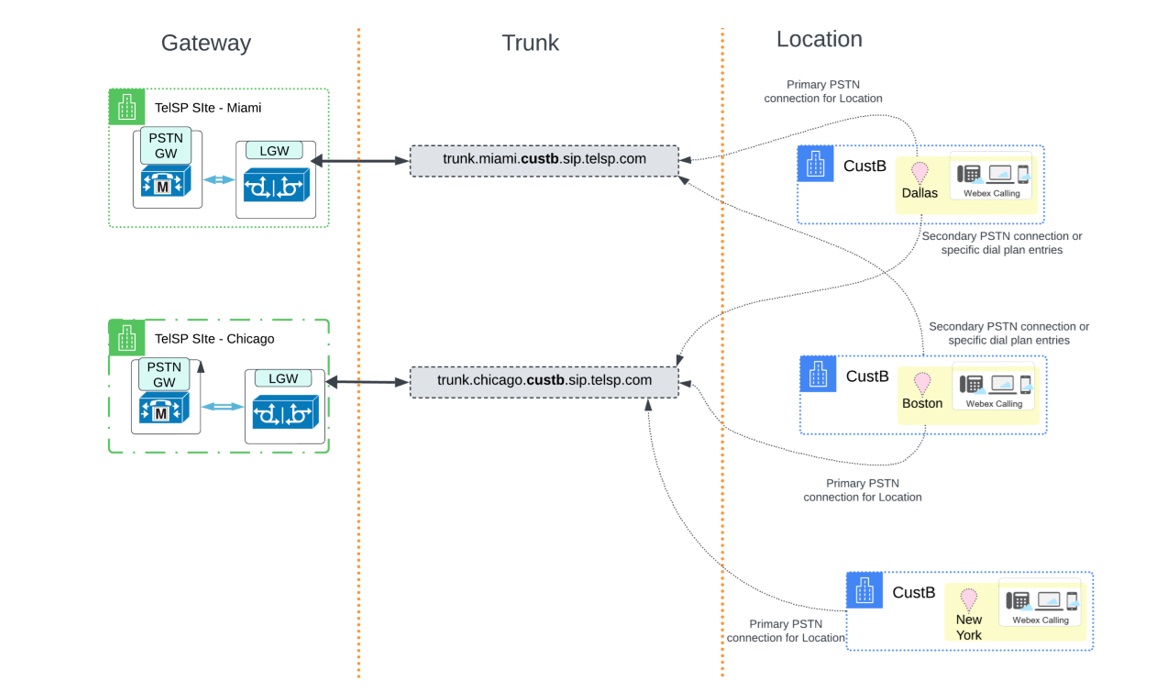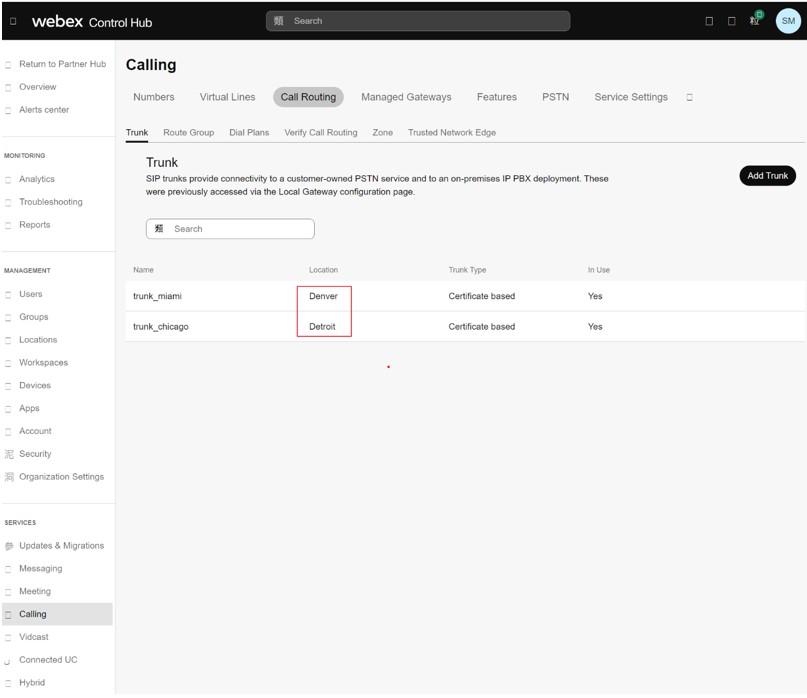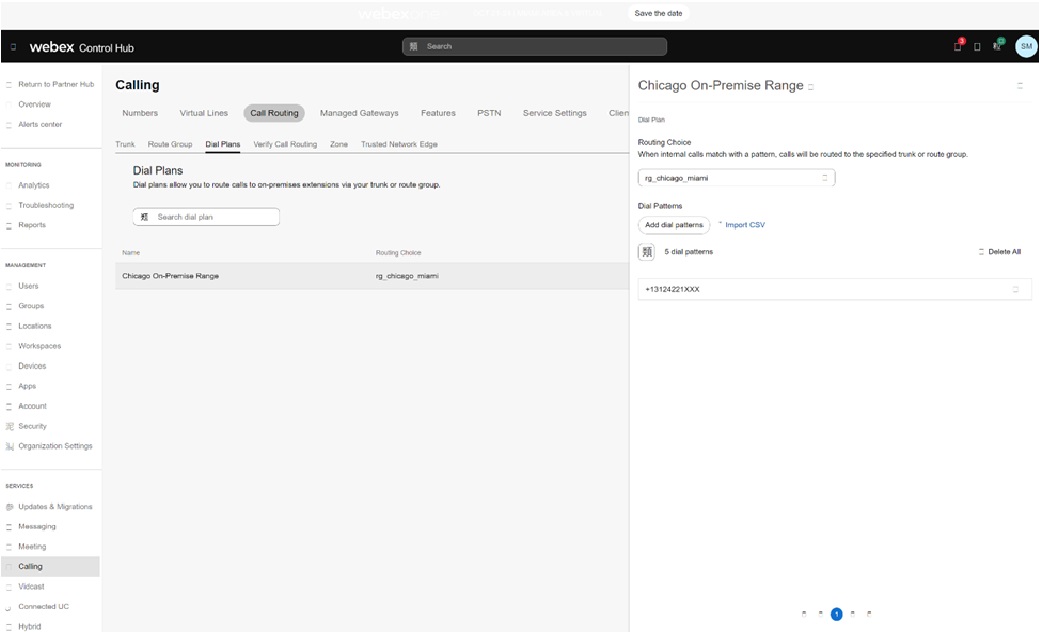- Головна
- /
- Стаття




Налаштування обслуговуваного партнера шлюзу
 У цій статті
У цій статті Надіслати відгук?
Надіслати відгук?Ці інструкції призначено для Партнерів, які мають намір організувати шлюз. Ознайомтеся з найкращими практиками та рекомендаціями.
Webex Calling дозволяє клієнту налаштувати транк локального шлюзу для надсилання та отримання виклику ТМЗК. Якщо партнер обслуговує транки від різних клієнтів, рекомендується налаштувати спільний шлюз для цих транків.
Цей документ окреслює схему високого рівня для реалізації обслуговуваного шлюзу партнера та зосереджується на транкінгу на основі сертифікатів. Модель на основі реєстрації — це проста модель для використання для обслуговуваного шлюзу партнера, яка забезпечує рішення для менших транків місткості. Це рішення має вбудовані технічні обмеження для транків високої пропускної здатності спеціально для моделі трафіку та спільного доступу до з’єднання на основі TCP. Основною причиною створення транкінгу на основі сертифікатів є вирішення масштабних обмежень моделі на основі реєстрації.
Процедура створення транка та конфігурації шлюзу подібна до локального шлюзу, розміщеного клієнтом. Детальніше дивіться: Початок роботи з локальним шлюзом
Міркування щодо розгортання
Розглянемо гіпотетичного партнера Webex на ім’я TelSP, щоб проілюструвати різні моделі розгортання, які може прийняти партнер.
Ось специфікації та вимоги високого рівня TelSP:
-
Партнер планує використовувати
sip.telsp.comяк домен найвищого рівня, який спільно використовується всіма клієнтами, якими вони керують. -
Партнер володіє
sip.telsp.comі може керувати інфраструктурою DNS і органами сертифікації, керувати DNS-адресами та підписувати сертифікати для цього домену та його піддоменів. -
Партнер може розгорнути два різних прикордонних контролери сеансів (фізичні або віртуальні) як локальні шлюзи для спільного доступу до ТМЗК між кінцевими клієнтами.
-
Партнер має два фізичні сайти, і обидва ці сайти мають спільне підключення до ТМЗК:
-
Маямі
-
Чикаго
-
-
TelSP управляє своїми локальними шлюзами від імені двох клієнтів CustA і CustB, як їх зазначено в цьому документі.
У цій статті термін «партнер» стосується партнера Webex, що керує, зокрема TelSP у цьому прикладі. Цей запис має доступ до партнерського центру Webex.
| Розташування | CustA | Каст Б |
|---|---|---|
|
Розташування, які використовують шлюз Майамі як основний пункт призначення ТМЗК |
Денвер |
Даллас |
|
Розташування, які використовують Chicago gateway як основний пункт призначення ТМЗК |
Детройт |
Бостон |
|
Субдомен, вибраний для клієнта | custa.sip.telsp.com | custb.sip.telsp.com |
Бажаним сценарієм є створення/припинення використання ТМЗК як для клієнтів, які використовують шлюзи Майамі, так і для Чикаго, надані партнером, як показано на ілюстрації:

Зв’язування розташування клієнта з транком і шлюзом
Webex Calling дозволяє створювати транки та надавати спільний доступ до транка в кількох місцях розташування. Під час створення транка зв’яжіть його з розташуванням.
Для CustA деталі транка такі:
| Ім’я транка | Повне доменне ім’я | Пов’язане розташування в визначенні транка |
|---|---|---|
| trunk_miami | trunk.miami.custa.sip.telsp.com | Денвер |
| trunk_chicago | trunk.chicago.custa.sip.telsp.com | Детройт |
На ілюстрації показано зв’язок розташування клієнта із шлюзом і транком для CustA:

У цьому розгортанні транк, пов’язаний із розташуванням, є основним підключенням до ТМЗК для цього розташування. Інший транк використовується як додаткове підключення до ТМЗК або маршрут для певних записів абонентської групи. Реалізація первинного та вторинного зв’язку з підключенням до ТМЗК здійснюється через концепцію групи маршрутів. Додаткову інформацію див. в розділі Налаштування клієнтів Webex .
Для CustB створюється подібне налаштування з такими транками:
| Ім’я транка | Повне доменне ім’я | Пов’язане розташування в визначенні транка |
|---|---|---|
| trunk_miami | trunk.miami.custb.sip.telsp.com |
Даллас |
| trunk_chicago | trunk.chicago.custb.sip.telsp.com |
Бостон |
На ілюстрації показано зв’язок розташування клієнта із шлюзом і транком для CustB:

На ілюстрації показано третє розташування, а саме Нью-Йорк, яке можна додати пізніше та вказати на trunk_chicago транк як його основне підключення до ТМЗК.
Вимоги до налаштування IP-адреси
Під час розгортання локального шлюзу, який має спільний доступ до кількох транків, Cisco надсилає ЗАПИТИ на використання унікального повного домену для кожного транка. Додаткову інформацію див. у розділі Configure-trunks,-route-groups,-and-dial-plans-for-Webex-Calling .
Використання IP-адреси та відомого порту на один транк є ідеальним вибором. Однак отримання загальнодоступної IPv4-адреси може бути проблематичним для деяких партнерів, які бажають використовувати одну адресу для шлюзу на одному вебсайті.
Тому прочитайте ці важливі вказівники:
-
Cisco не надсилає IP-адресу для транка.
-
Адреса транка може зіставлятися з унікальною IP-адресою або адресою, до якої надано спільний доступ між іншим транком.
-
Cisco рекомендує використовувати унікальний порт прослуховування на один транк з таких причин.
-
Забезпечує ізоляцію мережевого рівня між клієнтами
-
Для прикордонників сеансів характерно повторно використовувати ефемерне підключення сокета TCP, якщо не передбачено ізоляцію як унікальний клієнт, розділений IP-адресою, або унікальний порт прослуховування для клієнта.
-
Підключення або з’єднання на транк через ізоляцію клієнта забезпечують кращу пропускну здатність спеціально в умовах мережі з високою втратою даних. Тому трафік одного клієнта не впливає на іншого.
-
IP-адреса на шлюз: Конфігурація транка та рекомендації
Розгляньте ці приклади різних моделей для планування:
Модель 1: Унікальна IP-адреса в одному транку
У цій моделі всі транки, що обслуговуються обома шлюзами, вирішуються на унікальну IP-адресу, і кожен з цих транків може використовувати або не використовувати той самий порт, але в ідеалі той самий порт.

Представлення інформації у табличному форматі:
| Адреса транка (FQDN) | IP-адреса | Порт |
|---|---|---|
| trunk.miami.custa.sip.telsp.com | 10.170.158.200 | 5061 |
| trunk.miami.custb.sip.telsp.com | 10.170.158.201 | 5061 |
| trunk.chicago.custa.sip.telsp.com | 10.170.158.100 | 5061 |
| trunk.chicago.custb.sip.telsp.com | 10.170.158.101 | 5061 |
У цій же моделі партнер може використовувати адресу SRV. "Webex Calling дозволяє використовувати ""_sips._tcp"" як комбінацію служби та протоколу для виявлення однорангової адреси, якщо це запис SRV."
| Адреса транка (SRV) | Адреса SRV | Запис | IP-адреса | Порт |
|---|---|---|---|---|
| trunk.miami.custa.sip.telsp.com | _sips._tcp.trunk.miami.custa.sip.telsp.com | miami.custa.sip.telsp.com | 10.170.158.200 | 5061 |
| trunk.miami.custb.sip.telsp.com | _sips._tcp.trunk.miami.custb.sip.telsp.com | miami.custb.sip.telsp.com | 10.170.158.201 | 5061 |
| trunk.chicago.custa.sip.telsp.com | _sips._tcp.trunk.chicago.custa.sip.telsp.com | chicago.custa.sip.telsp.com | 10.170.158.100 | 5061 |
| trunk.chicago.custb.sip.telsp.com | _sips._tcp.trunk.chicago.custb.sip.telsp.com | chicago.custb.sip.telsp.com | 10.170.158.101 | 5061 |
Приклад вирішення запису SRV
nslookup
-type=srv _sips._tcp.trunk.miami.custa.sip.telsp.com Сервер: 8.8.8.8 Адреса: 8.8.8.8#53 Неавторитетна відповідь: _sips._tcp.trunk.miami.custa.sip.telsp.com = 3600 50 5061 miami.custa.sip.telsp.com Модель 2: Спільна IP-адреса в шлюзі, але різні порти прослуховування
У цій моделі всі транки, розміщені на локальному шлюзі Чикаго, зіставляються на одну IP-адресу, а всі транки, розміщені на локальному шлюзі Майамі, зіставляються на іншу IP-адресу. Однак у разі використання тієї ж IP-адреси кожен транк налаштовується за допомогою повного домену в Control Hub і налаштовується з унікальним портом.

| Адреса транка | IP-адреса | Порт |
|---|---|---|
| trunk.miami.custa.sip.telsp.com | 10.170.158.200 | 5061 |
| trunk.miami.custb.sip.telsp.com | 10.170.158.200 | 5062 |
| trunk.chicago.custa.sip.telsp.com | 10.170.158.100 | 5061 |
| trunk.chicago.custb.sip.telsp.com | 10.170.158.100 | 5062 |
У цій же моделі партнер використовує адресу SRV. "Webex Calling дозволяє використовувати ""_sips._tcp"" як комбінацію служби та протоколу для виявлення однорангової адреси, якщо це запис SRV."
| Адреса транка (SRV) | Адреса SRV | Запис | IP-адреса | Порт |
|---|---|---|---|---|
| trunk.miami.custa.sip.telsp.com | _sips._tcp.trunk.miami.custa.sip.telsp.com | miami.sip.telsp.com | 10.170.158.200 | 5061 |
| trunk.miami.custb.sip.telsp.com | _sips._tcp.trunk.miami.custb.sip.telsp.com | miami.sip.telsp.com | 10.170.158.200 | 5062 |
| trunk.chicago.custa.sip.telsp.com | _sips._tcp.trunk.chicago.custa.sip.telsp.com | chicago.sip.telsp.com | 10.170.158.100 | 5061 |
| trunk.chicago.custb.sip.telsp.com | _sips._tcp.trunk.chicago.custb.sip.telsp.com | chicago.sip.telsp.com | 10.170.158.100 | 5062 |
Інший приклад того, як запис SRV розв’язується наступним чином. У цьому прикладі існує 1 Запис на IP-адресу. Однак порт унікальний для кожної адреси та представлений через певну конфігурацію DNS, яка пов’язує адресу SRV із правильним портом.
nslookup
-type=srv _sips._tcp.trunk.miami.custa.sip.telsp.com Сервер: 8.8.8.8 Адреса: 8.8.8.8#53 Неавторитетна відповідь: _sips._tcp.trunk.miami.custa.sip.telsp.com = 3600 50 5061 miami.sip.telsp.com nslookup -type=srv _sips._tcp.trunk.miami.custb.sip.telsp.com Сервер: 8.8.8.8 Адреса: 8.8.8.8#53 Неавторитетна відповідь: _sips._tcp.trunk.miami.custb.sip.telsp.com = 3600 50 5062 miami.sip.telsp.com Налаштувати сервер домену та створити сертифікат
Партнер володіє telsp.com і його субдоменами. Тому сервер DNS і повноваження на отримання сертифікатів, підписаних затвердженим центром сертифікації, належать партнеру.
-
Cisco Webex очікує, що партнер опублікує адресу FQDN або SRV, включно з Записами, у загальнодоступний домен.
-
Cisco Webex очікує, що партнер використає один із органів сертифікації, наведених у цьому документі.
Під час використання повного домену як адреси транка налаштуйте підписані сертифікати з спільним ім’ям (CN) або альтернативним номером суб’єкта (SAN), установленим повними доменними іменами для транків.
| Шлюз, обслуговуваний партнером | Клієнт | Адреса транка | Сертифікат CN/SAN |
|---|---|---|---|
| Маямі | CustA | trunk.miami.custa.sip.telsp.com | trunk.miami.custa.sip.telsp.com |
| Каст Б | trunk.miami.custb.sip.telsp.com | trunk.miami.custb.sip.telsp.com | |
| Чикаго | CustA | trunk.chicago.custa.sip.telsp.com | trunk.chicago.custa.sip.telsp.com |
| Каст Б | trunk.chicago.custa.sip.telsp.com | trunk.chicago.custa.sip.telsp.com |
Для створення повних доменних імен у сертифікаті використовуйте один із наведених нижче способів:
-
Виберіть одне з повних доменних імен як спільне ім’я (CN), а решту як альтернативний номер суб’єкта (SAN).
-
Розмістіть домен верхнього рівня (sip.telsp.com) як CN, а всі повні доменні імена як SAN.
У майбутньому ви зможете перевірити сертифікат на основі домену верхнього рівня, який відповідає цій конфігурації.
Під час використання SRV як адреси транка налаштуйте підписані сертифікати з CN або SAN для частини хоста адреси SRV. Запис A або CNAME, на який зіставляється з адресою SRV, не потрібні.
| Шлюз, обслуговуваний партнером | Клієнт | Адреса транка | адреса SRV | Сертифікат CN/SAN |
|---|---|---|---|---|
| Маямі | CustA | trunk.miami.custa.sip.telsp.com | _sips._tcp.trunk.miami.custa.sip.telsp.com | trunk.miami.custa.sip.telsp.com |
| Каст Б | trunk.miami.custb.sip.telsp.com | _sips._tcp.trunk.miami.custb.sip.telsp.com | trunk.miami.custb.sip.telsp.com | |
| Чикаго | CustA | trunk.chicago.custa.sip.telsp.com | _sips._tcp.trunk.chicago.custa.sip.telsp.com | trunk.chicago.custa.sip.telsp.com |
| Каст Б | trunk.chicago.custb.sip.telsp.com | _sips._tcp.trunk.chicago.custb.sip.telsp.com | trunk.chicago.custb.sip.telsp.com |
Налаштувати шлюз
Використовуйте ці ресурси для налаштування локального шлюзу.
Щоб налаштувати Cisco CUBE, скористайтеся цією процедурою. Налаштування локального шлюзу в Cisco IOS XE для Webex Calling
Можна налаштувати затверджені сторонні SBC, див. розділ: Початок роботи з локальним шлюзом
Налаштуйте шлюз, обслуговуваний партнером, відповідно до цих рекомендацій: Початок роботи з локальним шлюзом
Налаштуйте кожен транк згідно з відповідними інструкціями для пристрою SBC. Щоб отримати інструкції Cisco CUBE, див. Налаштування локального шлюзу в Cisco IOS XE для Webex Calling
Налаштуйте голосові класи, вузли набору та групи вузлів для вхідного та вихідного трафіку для транка відповідно до зображення:
Конфігуруйте транки шлюзів у Control Hub
У партнерському центрі можна запустити Control Hub для CustA або CustB і налаштувати шлюз. Використовуйте цю процедуру для налаштування для кожного клієнта:
- Створіть транк – Додайте транк у розділі Виклики/Маршрутизація викликів/Транк для кожного партнера в спільному доступі. Щоб налаштувати транк, див. розділ Налаштування транків, груп маршрутів і абонентські групи для Webex Calling.
-
Додайте домен і підтвердьте – Додайте та підтвердьте наступний домен, який використовується для створення транка в розділі "Керування/Налаштування організації/Домени".
CustA Каст Б sip.telsp.com sip.telsp.com Під час додавання домену токен створюється й розміщується в записі TXT для домену на DNS-сервері партнера. Цей запис дозволяє Control Hub перевірити, що домен належить партнеру. Додаткову інформацію див. в розділі Керування доменами.
Оскільки Спільний домен використовується для перевірки в кожному клієнті. Однак, оскільки ця перевірка відбувається на рівні організації клієнта, переконайтеся, що для перевірки в кожній організації клієнта створено й використовується інший токен. Оскільки в організації клієнта використовується один домен, жодна організація не може претендувати на право власності на домен. - Налаштуйте адресу SBC з повним доменним ім’ям —
Для шлюзу Майамі:
Параметр CustA Каст Б Розташування Денвер Бостон Ім’я транка trunk_miami trunk_miami Тип транка На основі сертифіката На основі сертифіката Тип пристрою наприклад, Cisco Unified Border Element (або інший підтримуваний пристрій) наприклад, Cisco Unified Border Element (або інший підтримуваний пристрій) Тип адреси SBC Повне доменне ім’я Повне доменне ім’я Ім’я хоста trunk.miami.custa trunk.miami.custb Домен sip.telsp.com sip.telsp.com Порт 5061 5062 Повне доменне ім’я trunk.miami.custa.sip.telsp.com:5061 trunk.miami.custb.sip.telsp.com:5062 Максимальна кількість одночасних викликів (250–6500) 500 500 Для Чиказького шлюзу:
Параметр CustA Каст Б Розташування Детройт Даллас Ім’я транка trunk_chicago trunk_chicago Тип транка На основі сертифіката На основі сертифіката Тип пристрою наприклад, Cisco Unified Border Element (або інший підтримуваний пристрій) наприклад, Cisco Unified Border Element (або інший підтримуваний пристрій) Тип адреси SBC Повне доменне ім’я Повне доменне ім’я Ім’я хоста trunk.chicago.com trunk.chicago.custb Домен sip.telsp.com sip.telsp.com Порт 5061 5062 Повне доменне ім’я trunk.chicago.custa.sip.telsp.com:5061 trunk.chicago.custb.sip.telsp.com:5062 Максимальна кількість одночасних викликів (250–6500) 500 500 -
(Необов’язково) Не мають унікального імені транка серед клієнтів, і таке саме ім’я може допомогти у відстеженні транка.
-
Деякі SBC дозволяють налаштувати той самий порт, але ця конфігурація може вплинути на місткість. Тому використовуйте різні порти.
-
- Використання транків — виберіть будь-яке довільне розташування для транка через:
-
Будь-яке розташування може використовувати транк у з’єднанні ТМЗК.
-
Ви можете отримати доступ до транка через групу маршрутів.
-
Будь-яка абонентська група може використовувати транк.
-
Дивіться визначення транка з пов’язаними розташуваннями:

Ви можете використовувати ці транки для створення груп маршрутів. На зображенні група маршрутів rg_miami_chicago визначається, яка маршрутизує виклики до trunk_miami транка як основного параметра, а до trunk_chicago транка як додаткового параметра.

Можна визначити другу групу маршрутів, rg_chicago_miami яка маршрутизує виклики до trunk_chicago транка як основного параметра, а до trunk_miami транка як додаткового параметра.
-
Визначені транки та групи маршрутів тепер доступні в параметрі Підключення викликів ТМЗК для кожного розташування. На зображенні див. розташування в Денвері.

-
Ви можете використовувати транки та групи маршрутів у визначенні абонентської групи. Наприклад, локальний діапазон номерів у Чикаго для клієнта буде розділено на rg_chicago_miami групу маршрутів (для всіх розташувань) на зображенні:




